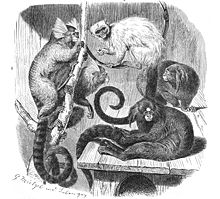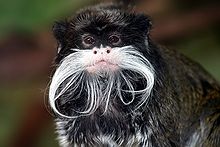 The Callitrichidae (synonym Hapalidae) is one of five families of New World monkeys. The family includes several genera, including themarmosets, tamarins, and lion tamarins. For a few years, this group of animals was regarded as a subfamily, called the Callitrichinae, of the Family Cebidae.
The Callitrichidae (synonym Hapalidae) is one of five families of New World monkeys. The family includes several genera, including themarmosets, tamarins, and lion tamarins. For a few years, this group of animals was regarded as a subfamily, called the Callitrichinae, of the Family Cebidae.This taxon was traditionally thought to be a primitive stem lineage, from which all the larger bodied platyrrhines evolved (see Hershkovitz, 1977). However, Dr Susan Ford has argued quite convincingly that callitrichids are actually a dwarfed lineage. The ancestral callitrichid would likely have been a "normal" sized cebid that was dwarfed through evolutionary time. This may exemplify a rare example of insular dwarfing in a mainland context, with the "islands" being formed by the extensive river networks in the Amazon Basin, which form effective biogeographic barriers.
All callitrichids are arboreal. They are the smallest of the anthropoid (i.e. simian) primates. They eat insects, fruit, and the sap or gum from trees; occasionally they will take small vertebrates. The marmosets rely quite heavily on exudates, with several species (Callithrix jacchus andCebuella pygmaea) considered obligate exudativores.
Callitrichids typically live in small, territorial groups of about 5 or 6 animals. Their social organization is unique among primates and is called "Cooperative polyandrous group". This communal breeding system involves groups of multiple males and females, but only one female is reproductively active. Females mate with more than one male and everyone shares the responsibility of carrying the offspring.[3]
They are the only primate group that regularly produce twins, which constitute over 80% of births in species that have been studied. Unlike other male primates, male callitrichids generally provide as much parental care as females, more in some cases. Typical social structure seems to constitute a breeding group, with several of their previous offspring living in the group and providing significant help in rearing the young.
Species list
- Family Callitrichidae
- Genus Cebuella
- Pygmy Marmoset, Cebuella pygmaea
- Genus Callibella
- Roosmalens' Dwarf Marmoset, Callibella humilis
- Genus Mico
- Silvery Marmoset, Mico argentatus
- Golden-white Bare-ear Marmoset, Mico leucippe
- Black-tailed Marmoset, Mico melanurus
- Aripuaña Marmoset, Mico intermedius
- Snethlage's Marmoset, Mico emiliae
- Black-headed Marmoset, Mico nigriceps
- Marca's Marmoset, Mico marcai
- Black-and-white Tassel-ear Marmoset, Mico humeralifer
- Golden-white Tassel-ear Marmoset, Mico chrysoleucus
- Maués Marmoset, Mico mauesi
- Satéré Marmoset, Mico saterei
- Manicoré Marmoset, Mico manicorensis
- Rio Acarí Marmoset, Mico acariensis
- Rondon's Marmoset, Mico rondoni
- Genus Callithrix
- Common Marmoset, Callithrix jacchus
- Black-tufted Marmoset, Callithrix penicillata
- Wied's Marmoset, Callithrix kuhlii
- White-headed Marmoset, Callithrix geoffroyi
- Buffy-tufted Marmoset, Callithrix aurita
- Buffy-headed Marmoset, Callithrix flaviceps
- Genus Callimico
- Goeldi's Marmoset, Callimico goeldii
- Genus Saguinus
- Black-mantled Tamarin, Saguinus nigricollis
- Brown-mantled Tamarin, Saguinus fuscicollis
- White-mantled Tamarin, Saguinus melanoleucus
- Golden-mantled Tamarin, Saguinus tripartitus
- Moustached Tamarin, Saguinus mystax
- White-lipped Tamarin, Saguinus labiatus
- Emperor Tamarin, Saguinus imperator
- Red-handed Tamarin, Saguinus midas
- Black Tamarin, Saguinus niger
- Mottle-faced Tamarin, Saguinus inustus
- Pied Tamarin, Saguinus bicolor
- Martins's Tamarin, Saguinus martinsi
- White-footed Tamarin, Saguinus leucopus
- Cottontop Tamarin, Saguinus oedipus
- Geoffroy's Tamarin, Saguinus geoffroyi
- Genus Leontopithecus
- Golden Lion Tamarin, Leontopithecus rosalia
- Golden-headed Lion Tamarin, Leontopithecus chrysomelas
- Black Lion Tamarin, Leontopithecus chrysopygus
- Superagui Lion Tamarin, Leontopithecus caissara
- Genus Cebuella

Tidak ada komentar:
Posting Komentar